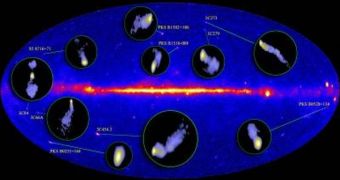The brightest galaxies that the Fermi Space Telescope sees are the most active in terms of radio emissions, but, at times, the observatory alone is not capable of peering very deep into the stellar formations. When lots of data gather, and a better tool is needed, experts turn to the world's largest radio observer, the National Science Foundation's (NSF) Very Long Baseline Array (VLBA), located all around the United States.
When readings from all terminals are combined with complex software, the array acts like a single radio disc, with a 5,300-mile (8,600-kilometer) diameter. Antennas for the VLBA are located in Hawaii, Washington, California, Arizona, New Mexico, Texas, Iowa, New Hampshire, and the US Virgin Islands, and each of the stations consists of an 82-foot (25-meter) -diameter dish antenna and a control building next to it.
The ten observatories are operated by the National Radio Astronomy Observatory, which has given Max Planck Institute for Radio Astronomy expert Yuri Kovalev and his team access to the array for their new studies. According to statistics, the VLBA is able to resolve details a million times smaller than Fermi, and more than 50 times smaller than even the most powerful optical telescope.
The goal of the new research has been to further and deeper analyze the correlation between gamma-ray emissions and powerful radio-emitting jets. Peering into these jets is not easy for any telescope other than the VLBA, whose unique configuration and setup allow for meticulous and detailed data to be gathered.
“Now we know for sure that the fastest, most compact, and brightest jets we see with radio telescopes are the ones that are able to kick light up to the highest energies. We see the innermost few hundred light-years of these jets for even the most distant active galaxies seen by Fermi,” Kovalev said.
“For more than a decade, we have collected images of the brightest galaxies in the radio sky to study the changing structures of their jet. We've waited a long time to compare our measurements with the findings in the gamma-ray sky – and now, thanks to this state-of-the-art space observatory, we finally can,” Fermi's guest investigator and leader of the MOJAVE program, Purdue University Professor Matthew Lister, who has also been a member of the research team, added. The MOJAVE is a long-term project, meant to study the radio jets coming from the most active galaxies in the Universe.

 14 DAY TRIAL //
14 DAY TRIAL //